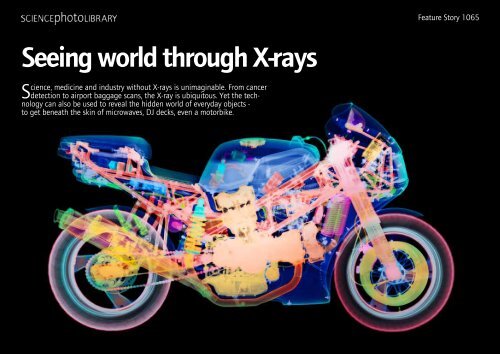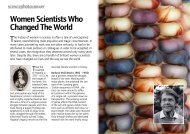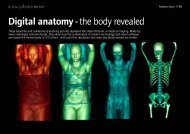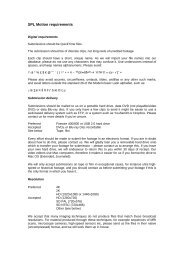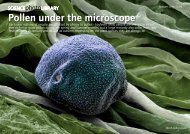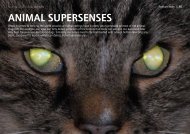Seeing world through X-rays - Science Photo Library
Seeing world through X-rays - Science Photo Library
Seeing world through X-rays - Science Photo Library
Create successful ePaper yourself
Turn your PDF publications into a flip-book with our unique Google optimized e-Paper software.
Feature Story 1065<br />
<strong>Seeing</strong> <strong>world</strong> <strong>through</strong> X-<strong>rays</strong><br />
S<br />
cience, medicine and industry without X-<strong>rays</strong> is unimaginable. From cancer<br />
detection to airport baggage scans, the X-ray is ubiquitous. Yet the technology<br />
can also be used to reveal the hidden <strong>world</strong> of everyday objects -<br />
to get beneath the skin of microwaves, DJ decks, even a motorbike.
<strong>Science</strong> <strong>Photo</strong> <strong>Library</strong> Feature Stories - <strong>Seeing</strong> the <strong>world</strong> <strong>through</strong> X-<strong>rays</strong><br />
“X-ray photography gives you<br />
the ability to see <strong>through</strong><br />
things, to see past our normal<br />
perception of the objects that<br />
surround us,” says photographer<br />
Hugh Turvey.<br />
Turvey is one half of an<br />
artistic partnership - the other<br />
partner is Artemi Kyriacou -<br />
called Gusto. They specialise in<br />
making high-quality scientific<br />
images for advertising and<br />
industry. For this series, Gusto<br />
began by taking X-<strong>rays</strong> of each<br />
object at several different densities,<br />
or ‘layers’:<br />
“Three-dimensional objects<br />
aren’t that uniform in terms of<br />
density,” says Turvey. “So we<br />
can’t take just one X-ray.”<br />
Each density layer is scanned<br />
into a computer, and the final<br />
image begins to<br />
take shape: “The images are a<br />
complex mix of photography<br />
and X-ray,” says Turvey. “In<br />
some examples, there’s more<br />
X-ray and less photography; in<br />
others the reverse. We try to<br />
produce what we consider to<br />
be the best balanced image.”<br />
The process is not as simple<br />
as it sounds. A standard X-ray<br />
plate measures about 43 by 35<br />
cm. For small objects like the<br />
hair dryer and the headphones,<br />
that’s not a problem - they fit<br />
on the plate. But for larger
<strong>Science</strong> <strong>Photo</strong> <strong>Library</strong> Feature Stories - <strong>Seeing</strong> the <strong>world</strong> <strong>through</strong> X-<strong>rays</strong><br />
objects like the washing machine and<br />
the central heating boiler, Gusto had to<br />
make several exposures and then stitch<br />
them together in the computer.<br />
By far the most stunning - and complex<br />
- image is that of the Ducati motorbike.<br />
Because of its size, Gusto had<br />
to make 30 exposures just to complete<br />
one density layer. Then they found that<br />
the X-<strong>rays</strong> weren’t powerful<br />
enough to penetrate the densest areas<br />
of the bike, like the engine block. So<br />
they turned to another, more powerful<br />
technique - gamma ray photography<br />
- which is used in industry to examine<br />
things like welds in airframes. This<br />
allowed them to ‘see’ further into the<br />
bike:<br />
“Because it was so large, the Ducati<br />
was the most technically challenging<br />
object,” says Turvey, “but it was also the<br />
most satisfying. The X-ray image of the<br />
Ducati is a visual explanation of how a<br />
motorbike works - but it also<br />
shows you how clever and intricate its<br />
construction is, and how much skill<br />
goes into its design.”<br />
ENDS 410 WDS © SCIENCE PHOTO<br />
LIBRARY
FULL PICTURE SET<br />
For captions and credits, please refer to the captions.txt file<br />
<strong>Science</strong> <strong>Photo</strong> <strong>Library</strong> Feature Stories - <strong>Seeing</strong> the <strong>world</strong> <strong>through</strong> X-<strong>rays</strong><br />
For further information, please contact: seymour@sciencephoto.com<br />
All images are copyright, please credit images as stated on the captions
<strong>Science</strong> <strong>Photo</strong> <strong>Library</strong> Feature Stories - <strong>Seeing</strong> the <strong>world</strong> <strong>through</strong> X-<strong>rays</strong><br />
For further information, please contact: seymour@sciencephoto.com<br />
All images are copyright, please credit images as stated on the captions


